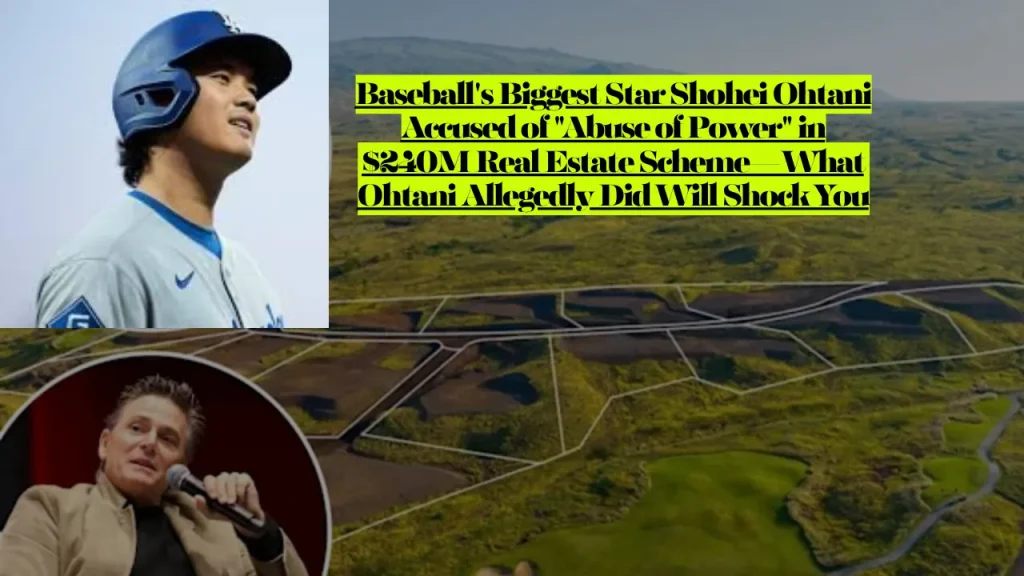Baseball’s Biggest Star Shohei Ohtani Accused of “Abuse of Power” in $240M Real Estate Scheme—What Ohtani Allegedly Did Will Shock You
Shohei Ohtani, baseball’s $700 million man, is facing explosive allegations in a Hawaii lawsuit claiming he and his agent weaponized their celebrity status to destroy the very people who brought them into a luxury real estate deal. The Ohtani Hawaii lawsuit, filed in August 2025, accuses the Los Angeles Dodgers superstar of “abuse of power” that cost developers millions—but Ohtani’s legal team is firing back with claims the developers illegally exploited his fame for profit.
The $240 Million Paradise Project That Turned Into Legal Hell
Developer Kevin J. Hayes Sr. and real estate broker Tomoko Matsumoto filed the lawsuit in Hawaii Circuit Court, alleging they were pushed out of a $240 million luxury housing development called The Vista at Mauna Kea Resort on the Big Island’s coveted Hapuna Coast.
Hayes and Matsumoto had been working on the project since 2013, conceiving, investing in, developing, and marketing the housing project designed to attract luxury property buyers, with properties averaging approximately $17.3 million each.
What they envisioned:
- 14 ultra-luxury residences on Hawaii’s Big Island
- Homes priced from $4.5 million to $20 million each
- Total project value: $240 million
- Target market: Japanese luxury vacation home buyers
- Celebrity endorsement to drive sales
In 2023, they reached a deal with Ohtani to be a celebrity endorser and spokesperson, with Ohtani expected to own one of the 14 residences on the property. The project wanted Ohtani on board to create buzz within the Japanese luxury vacation home market.
Everything seemed perfect—until Ohtani’s agent allegedly turned the dream into a nightmare.
The “Disruptive Force”: How Ohtani’s Agent Allegedly Took Over
The lawsuit claims Balelo “inserted himself into every aspect of the relationship” and called him a “disruptive force” that responded to business matters with stonewalling or hostility.
According to the lawsuit, Ohtani’s agent, Nez Balelo of Creative Artists Agency (CAA), increasingly demanded concessions from Hayes and Matsumoto before demanding that their business partner, Kingsbarn Realty Capital, drop them from the deal.
The escalating pattern:
- Initial agreement: Ohtani as celebrity spokesperson
- Balelo inserts himself into every business decision
- Increasing demands and ultimatums
- Threats to pull Ohtani from the deal
- Pressure campaign against other investors
- Coordinated termination of Hayes and Matsumoto
The suit said Balelo “quickly became a disruptive force,” threatening to pull Ohtani from the deal if concessions weren’t made.
The plaintiffs allege that unless they conceded to Balelo’s ever-increasing demands, Ohtani would walk away from the entire project—leaving the development worthless.
Related article: Florida Sheriff Bob Gualtieri Says “I’ll Arrest You”—Despite AG Saying Open Carry Is Now Legal. Who’s Right?

The “Coordinated Ambush”: How They Got Fired From Their Own Project
In what the suit called “a coordinated ambush” last month, Hayes and Matsumoto were summoned to a Zoom call where Kingsbarn “abruptly” informed them they were out.
The lawsuit claimed that Kingsbarn admitted Balelo demanded Hayes and Matsumoto be removed from the deal, stating “Kingsbarn openly admitted during the call that Balelo had demanded the terminations and that they were being done solely to placate him”.
How the termination went down:
- Hayes and Matsumoto received brief phone call
- Summoned to emergency Zoom meeting
- Given no warning or opportunity to respond
- Told their business partner chose Ohtani over them
- Lost millions in projected compensation
- Excluded from project they conceived and built
“Kingsbarn began capitulating to Balelo’s every whim,” the suit said, adding “it became increasingly obvious that Kingsbarn was more concerned about preserving its relationship with Otani than honoring its obligations to its business partners”.
The Legal Bombshell: What Hayes and Matsumoto Are Claiming
The lawsuit doesn’t hold back. Hayes and Matsumoto accuse Ohtani and Balelo of tortious interference with contractual and business relations and unjust enrichment.
The core allegations:
“Balelo and [Ohtani], who were brought into the venture solely for [Ohtani’s] promotional and branding value, exploited their celebrity leverage to destabilize and ultimately dismantle Plaintiffs’ role in the project—for no reason other than their own financial self-interest,” the lawsuit claims.
“This case is about abuse of power,” the lawsuit says. “Defendants used threats and baseless legal claims to force a business partner to betray its contractual obligations and strip Plaintiffs of the very project they conceived and built”.
“Defendants must be held accountable for their actions, not shielded by fame or behind-the-scenes agents acting with impunity. Plaintiffs bring this suit to expose Defendants’ misconduct and to ensure that the rules of contract, fair dealing, and accountability apply equally to all—celebrity or not”.
What they stand to lose:
- Millions in projected homebuilding profit
- Construction management fees
- Broker commissions on $17 million homes
- Decade-plus investment of time and resources
- Control of project they originated
Ohtani Fires Back: “You Stole My Image”
In September 2025, Ohtani and Balelo filed a motion to dismiss that flips the script entirely.
The motion argues the dispute arises from Hayes and Matsumoto’s “attempt to get close to celebrity athlete Shohei Ohtani in order to profit off him unlawfully”.
Ohtani’s counternarrative:
The defense claims Hayes and Matsumoto used Ohtani’s name and photograph to “drum up traffic” to a website that marketed their own side project development without authorization and without paying Ohtani for that use.
“They engaged in this self-dealing without authorization, and without paying Ohtani for that use, in a selfish and wrongful effort to take advantage of their proximity to the most famous baseball player in the world,” attorneys for Ohtani wrote.
The defense attorneys portray Balelo as doing his job as an agent and protecting his client by “expressing justifiable concern” about alleged “misuse” of Ohtani’s name, image, and likeness (NIL).
“When Balelo did his job and protected his client by expressing justifiable concern about this misuse and threatening to take legal action against this clear misappropriation, Plaintiffs decided the best defense was a good offense. They rushed to court and sued first”.

The NIL Controversy: Who’s Telling The Truth?
The case hinges on whether Hayes and Matsumoto improperly used Ohtani’s name, image, and likeness—or whether that’s just a convenient excuse to cover up a power grab.
In October 2025, lawyers for Hayes and Matsumoto denied any improper use of Ohtani’s likeness and alleged Balelo was trying to deflect blame for cost overruns at Ohtani’s home.
Hayes and Matsumoto’s defense:
“The allegations as we clarified them make very clear that there was never a breach of the endorsement agreement, the video that was posted on the website promoting specifically this project was sent to Balelo and CAA and another adviser to Ohtani, Mark Daulton, and they were aware of it and never objected to it,” said Josh Schiller, a lawyer for Hayes.
“Before the website went live, Hayes submitted a link to the entire site—including its promotional aspects—by email to Balelo and Terry Prince, the director of legal and business Affairs at CAA Sports LLC,” the amended complaint said.
The competing narratives:
Hayes/Matsumoto version: We sent Balelo everything before going live, he approved it, then later used it as a pretext to force us out.
Ohtani/Balelo version: They exploited Ohtani’s fame for their side projects without authorization, and we had to stop it.
Someone is lying. The question is who.
The Smoking Gun: What Investment Documents Reveal
The marketing materials for The Vista at Mauna Kea Resort tell a fascinating story.
Investment materials that remained online called Ohtani “Japan’s Babe Ruth” and the “1st Resident”—giving him top billing ahead of the iconic Mauna Kea Resort, Hapuna Beach (rated the #1 beach in America by Conde Nast Traveler), and two golf courses designed by Arnold Palmer and Robert Trent Jones Sr.
“Ohtani will act as the celebrity spokesperson for the project and has committed to purchasing one of the 14 residences within the project,” the brochure says. “He also intends to spend significant time at The Vista in the off-season and will construct a small hitting and pitching facility for preseason training”.
“This partnership with Ohtani will elevate the demand and create buzz within the Japanese luxury vacation home market, which is a primary target audience for the project,” the investment brochure said. “We see Shohei Ohtani’s homeownership as having a significant impact on the global exposure of the project and expect to accelerate the pace of sales, thereby helping us achieve our pricing objectives”.
What this reveals: The entire project was built around Ohtani’s celebrity. Without him, the development likely fails. That gave Ohtani and Balelo enormous leverage—leverage the lawsuit claims they weaponized.
The Cost Overrun Bombshell
In October 2025, the amended complaint dropped a new allegation that adds another layer to the drama.
“Balelo and CAA sought to deflect blame by scapegoating Hayes for the cost overruns on Otani’s home—overruns caused entirely by defendants’ own decisions,” the complaint said.
This suggests Ohtani’s personal residence within the development went over budget, and rather than accept responsibility, Balelo allegedly blamed Hayes—then used that as justification to have him removed.
“The sudden demand that Kingsbarn terminate plaintiffs was instead a retaliatory measure against Hayes for resisting the constant and improper demands of Balelo and (Ohtani),” the complaint added.
The pattern that emerges:
- Ohtani’s home goes over budget
- Balelo blames the developers
- Developers push back on unfair accusations
- Balelo retaliates by forcing them out
- Uses NIL violation as legal cover
Is Ohtani Even Guilty? The Agent Problem
One of the most intriguing aspects of this case is that Ohtani himself may not have done anything wrong.
One of the plaintiffs’ attorneys, Joshua I. Schiller of Boies Schiller Flexner, said “it’s uncertain at this time whether [Balelo’s] alleged contractual interference and misdeeds were even known to Mr. Ohtani at the time, or whether he may have himself been misled by Mr. Balelo—but we aim to find out”.
The “innocent client” theory:
The motion to dismiss argues that Ohtani shouldn’t even be a defendant since he isn’t accused of specific misconduct.
This raises fascinating questions:
- Did Balelo act without Ohtani’s knowledge?
- Is Ohtani a victim of his own agent’s aggressive tactics?
- Did Ohtani authorize the pressure campaign?
- Could Ohtani turn on Balelo to save himself?
The plaintiffs may hope that Ohtani points the blame at his agent and boosts their case against Balelo.
If Ohtani testifies that Balelo acted without authorization, the entire lawsuit pivots from “celebrity abuse of power” to “rogue agent betrays everyone.”
The Second Project: It Gets Worse
Hayes and Matsumoto say that Ohtani and Balelo also tried to undermine their interests in a second, neighboring venture.
This wasn’t just about one development. The lawsuit alleges a systematic effort to push Hayes and Matsumoto out of multiple projects—suggesting this wasn’t about protecting NIL rights but about seizing control of valuable real estate opportunities.
Why the second project matters:
If Ohtani and Balelo targeted Hayes and Matsumoto across multiple deals, it becomes harder to argue this was just about unauthorized use of Ohtani’s image. It looks more like a pattern of using celebrity leverage to take over profitable projects.
What Kingsbarn Says: “Frivolous and Without Merit”
Kingsbarn Realty Capital, the business partner who actually fired Hayes and Matsumoto, has its own version of events.
In a statement to The Associated Press, Kingsbarn called the allegations “completely frivolous and without merit”.
Kingsbarn’s position is that Hayes and Matsumoto learned they had “siphoned off the joint venture’s rights in Ohtani’s NIL” for their personal use, putting their interests above the project.
Kingsbarn’s narrative:
- Hayes and Matsumoto violated the agreement
- They used Ohtani’s name without authorization
- Kingsbarn had to protect the project and Ohtani
- The termination was justified, not coerced
But the lawsuit claims Kingsbarn admitted on the Zoom call that Balelo demanded the terminations. Can both be true?
The Legal Stakes: Tortious Interference Explained
The lawsuit accuses Ohtani and Balelo of tortious interference with contractual and business relations and unjust enrichment.
What is tortious interference?
Tortious interference occurs when someone intentionally damages another person’s contractual or business relationships. To win, Hayes and Matsumoto must prove:
- They had valid business relationships (with Kingsbarn)
- Ohtani/Balelo knew about those relationships
- Ohtani/Balelo intentionally interfered
- The interference caused actual harm
- Damages resulted from the interference
The “unjust enrichment” claim:
Unjust enrichment means Ohtani and Balelo received benefits they didn’t deserve at Hayes and Matsumoto’s expense. If the development succeeds using Hayes and Matsumoto’s decade of work but they receive nothing, that’s unjust enrichment.
What Hayes and Matsumoto must prove:
- Ohtani/Balelo intentionally pressured Kingsbarn
- The pressure caused Hayes/Matsumoto’s termination
- The termination was improper
- Hayes/Matsumoto suffered quantifiable damages
- Ohtani/Balelo benefited from the interference
The Celebrity Defense: Does Fame Trump Everything?
Ohtani’s defense strategy is clear: Famous people have the right to control their image, and agents have the duty to protect those rights aggressively.
“Nez Balelo has always prioritized Shohei Ohtani’s best interests, including protecting his name, image, and likeness from unauthorized use,” said Laura Smolowe, a lawyer for Ohtani and Balelo.
The legal question: Where’s the line between protecting celebrity NIL rights and abusing celebrity power to destroy business partners?
Balelo is depicted as engaging in “advocacy for his world-famous client, and legitimate, and understandable, efforts to secure him the fairest deal”.
But if Balelo threatened litigation knowing the NIL use was authorized (as Hayes claims), then it’s not protection—it’s extortion.
What Happens Next: The Legal Timeline
Attorneys for Ohtani and Balelo warned that if the complaint against their clients isn’t dismissed, they “intend to file appropriate counterclaims” against Hayes and Matsumoto for unauthorized misappropriation of Ohtani’s NIL.
Short-term outlook:
- Court rules on motion to dismiss
- If not dismissed, discovery begins
- Both sides exchange evidence and depositions
- Counterclaims potentially filed by Ohtani
Medium-term scenarios:
- Settlement negotiations (most likely outcome)
- Summary judgment motions
- Trial preparation
- Media circus as details emerge
Long-term implications:
- Precedent for celebrity endorsement deals
- Guidance on NIL rights in real estate
- Agent fiduciary duty standards
- Celebrity power vs. contract rights
The case is before Judge Jordon J. Kimura in Hawaii Circuit Court.
The $700 Million Man: Can Ohtani’s Reputation Survive?
Ohtani signed a 10-year, $700 million contract with the Dodgers (with $680 million deferred), making him the highest-paid athlete in baseball history. His pristine image is worth billions in endorsements.
What’s at stake for Ohtani:
- Reputation as humble, scandal-free superstar
- Future endorsement opportunities
- Public perception in Japan and U.S.
- Legacy beyond baseball statistics
If the lawsuit reveals Ohtani actively participated in “abuse of power” tactics, it could damage the carefully cultivated image that makes him so valuable to brands.
But if Ohtani was genuinely unaware of Balelo’s actions, he could emerge as another victim—the famous athlete exploited by those around him (a familiar story in sports).
The Bigger Picture: Celebrity Power in Business Deals
This case highlights a troubling dynamic in modern celebrity business relationships.
The power imbalance:
- Celebrities provide star power that makes deals viable
- Developers/partners do the actual work
- Agents control access to the celebrity
- Partners become dependent on celebrity participation
- That dependency creates leverage for exploitation
The pattern:
- Developer needs celebrity endorsement
- Celebrity brings instant credibility and buyers
- Agent demands increasing concessions
- Developer capitulates to keep celebrity attached
- Eventually, developer gets cut out entirely
- Celebrity and agent take over the profitable project
Is this savvy business or abuse of power? The lawsuit says it’s the latter.
What Other Celebrities and Developers Should Learn
For developers bringing in celebrity endorsers:
Get everything in writing: Specify exactly how NIL can be used, with whom materials must be approved, and timelines for approval.
Limit agent involvement: Define the agent’s role clearly and restrict their authority over business decisions.
Protect against removal: Include contractual provisions preventing the celebrity from forcing out founding partners.
Document everything: Keep records of all approvals, communications, and agreements.
For celebrities entering endorsement deals:
Trust but verify: Don’t assume your agent is acting in your best interest—get independent legal advice.
Understand what you’re endorsing: If your agent is making threats and demands, you could be liable for their actions.
Protect your image: But don’t weaponize it against legitimate business partners.
For agents representing celebrity clients:
Fiduciary duty matters: You work for the client, but you can’t commit tortious interference on their behalf.
Document NIL violations: If there’s unauthorized use, create a clear record before taking action.
Negotiate, don’t threaten: Aggressive tactics may work short-term but create legal liability.
Expert Analysis: Who’s Likely To Win?
Legal experts are divided on the case’s likely outcome.
Factors favoring Hayes and Matsumoto:
- If they can prove they had authorization for NIL use
- Evidence of Balelo pressuring Kingsbarn
- Kingsbarn’s alleged admission on Zoom call
- Pattern of demands and threats
- Documented cost overrun scapegoating
Factors favoring Ohtani and Balelo:
- NIL rights are taken very seriously by courts
- Agents have broad authority to protect clients
- Hayes/Matsumoto were minority partners
- Kingsbarn denies the allegations
- Ohtani’s limited personal involvement
Most likely outcome: Settlement. These cases rarely go to trial. Expect:
- Confidential financial settlement
- Non-disparagement agreements
- Hayes and Matsumoto exit the project
- Both sides claim victory
- Truth remains buried under NDAs
The Uncomfortable Questions Nobody’s Asking
Question 1: If Ohtani’s involvement was crucial to the project’s viability, didn’t that give him and Balelo legitimate negotiating leverage?
Question 2: If Hayes and Matsumoto were using Ohtani’s image to promote their side projects, wasn’t Balelo right to object?
Question 3: Why did Kingsbarn choose Ohtani over its founding partners if the termination was truly unjustified?
Question 4: Could this entire dispute be about money—with both sides trying to maximize their share of a very profitable project?
Question 5: Does being a celebrity give you the right to destroy people’s businesses, or does signing an endorsement deal mean you’re contractually obligated to play nice?
FAQs About The Ohtani Hawaii Lawsuit
Q: What is Shohei Ohtani being sued for in Hawaii?
A: Ohtani and his agent Nez Balelo are being sued by real estate developer Kevin Hayes and broker Tomoko Matsumoto for tortious interference and unjust enrichment related to a $240 million luxury housing development on Hawaii’s Big Island. The plaintiffs claim Ohtani and Balelo used their celebrity leverage to force them out of the project.
Q: What is The Vista at Mauna Kea Resort project?
A: It’s a luxury residential development within the Mauna Kea Resort on Hawaii Island’s Hapuna Coast, featuring 14 ultra-luxury homes averaging $17.3 million each. Ohtani signed an endorsement deal in 2023 to be the celebrity spokesperson and was expected to purchase one of the residences.
Q: What is Ohtani’s defense against the lawsuit?
A: Ohtani and Balelo filed a motion to dismiss, claiming Hayes and Matsumoto illegally used Ohtani’s name, image, and likeness to promote their own side projects without authorization or payment. They argue Balelo was simply protecting Ohtani’s NIL rights as any agent should.
Q: Did Shohei Ohtani personally do anything wrong?
A: That’s unclear. One of the plaintiffs’ attorneys stated it’s uncertain whether Ohtani even knew about Balelo’s alleged misconduct or whether Ohtani was himself misled by his agent. Ohtani’s defense argues he shouldn’t even be a defendant since he’s not accused of specific wrongdoing.
Q: What does “tortious interference” mean in this case?
A: Tortious interference occurs when someone intentionally damages another person’s business relationships. Hayes and Matsumoto claim Ohtani and Balelo deliberately pressured their business partner (Kingsbarn Realty Capital) to terminate them from the project, causing them to lose millions in projected compensation.
Q: How much money is at stake in the lawsuit?
A: Hayes and Matsumoto claim they stand to lose millions of dollars in compensation tied to projected homebuilding profit, construction management fees, and broker commissions. The exact amount hasn’t been specified publicly, but with homes averaging $17.3 million each, the damages could be substantial.
Q: What is Nez Balelo’s role in this controversy?
A: Balelo is Ohtani’s agent at Creative Artists Agency (CAA). The lawsuit portrays him as a “disruptive force” who made increasing demands, threatened to pull Ohtani from the deal, and ultimately pressured Kingsbarn to fire Hayes and Matsumoto. Balelo’s defense is that he was protecting Ohtani’s NIL rights.
Q: Could Ohtani lose this case?
A: It’s possible but unlikely to go to trial. If the case isn’t dismissed and proceeds to discovery, both sides face risks. Most high-profile cases like this settle confidentially. The outcome depends on what evidence emerges about NIL authorization, Balelo’s conduct, and Ohtani’s knowledge and involvement.
Conclusion: Fame, Power, and Paradise Lost
The Ohtani Hawaii lawsuit is about more than real estate—it’s about power dynamics in celebrity business relationships and whether fame entitles you to destroy the people who help you.
Hayes and Matsumoto spent over a decade developing a dream project. They brought in Ohtani to make it viable. Then, according to their lawsuit, Ohtani’s agent used that dependence as leverage to force them out of their own creation.
Ohtani and Balelo claim they were protecting legitimate NIL rights against people exploiting Ohtani’s fame for unauthorized purposes. They argue Balelo did exactly what agents are supposed to do: protect their client.
The truth likely lies somewhere between these narratives. Maybe Hayes and Matsumoto did misuse Ohtani’s image. Maybe Balelo overreacted and weaponized that violation to seize control. Maybe everyone saw an opportunity to maximize their profit at others’ expense.
What’s certain is that paradise turned into a legal battlefield, friendships became lawsuits, and a project meant to showcase luxury became a cautionary tale about celebrity power.
The case continues. Discovery will reveal emails, texts, and Zoom recordings that tell the real story. Settlement negotiations are likely already underway. And somewhere in Hawaii, 14 luxury home sites sit waiting for resolution—a $240 million monument to what happens when fame, money, and ambition collide.
Legal Disclaimer: This article is for informational and educational purposes only and does not constitute legal advice. The information presented is based on publicly available court documents, legal filings, and media reports current as of October 2025. The case is ongoing and allegations have not been proven in court. This article presents claims from both parties without prejudging the outcome. For specific legal guidance regarding real estate disputes, celebrity endorsements, or NIL rights, consult with a qualified attorney licensed in your jurisdiction.
About the Author

Sarah Klein, JD, is a licensed attorney and legal content strategist with over 12 years of experience across civil, criminal, family, and regulatory law. At All About Lawyer, she covers a wide range of legal topics — from high-profile lawsuits and courtroom stories to state traffic laws and everyday legal questions — all with a focus on accuracy, clarity, and public understanding.
Her writing blends real legal insight with plain-English explanations, helping readers stay informed and legally aware.
Read more about Sarah
